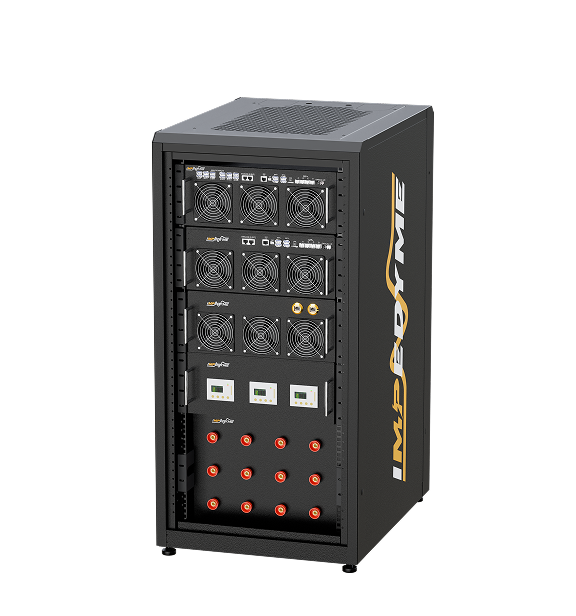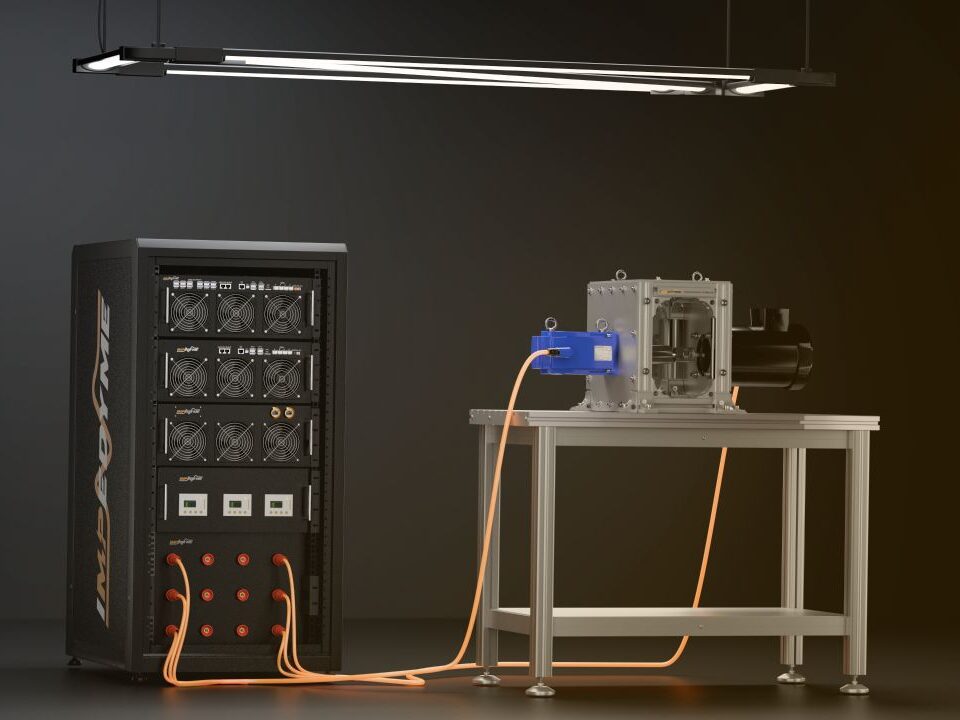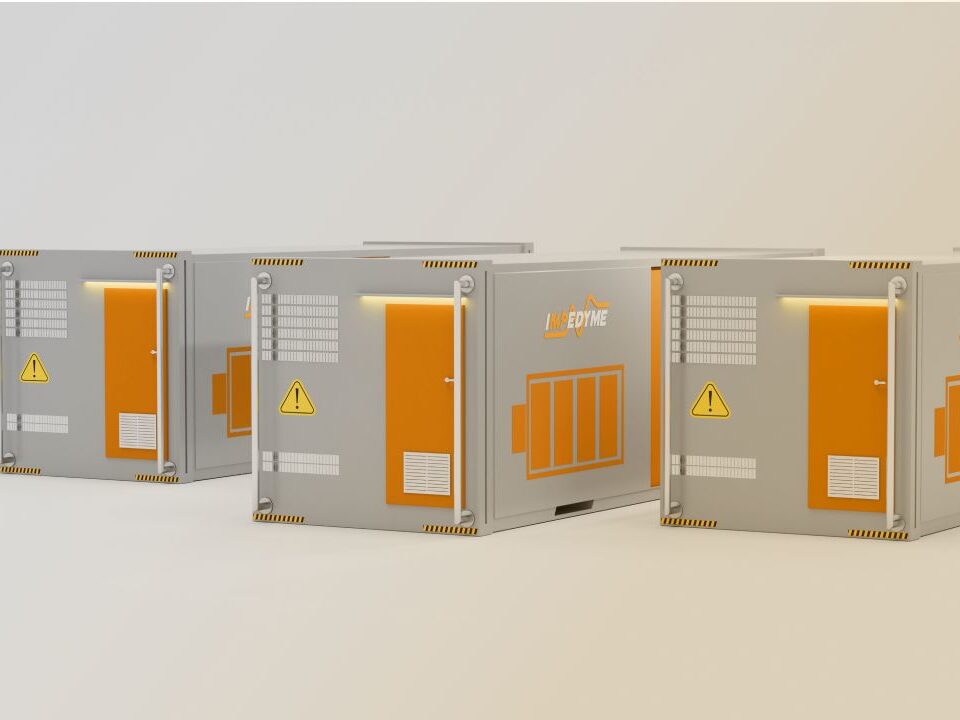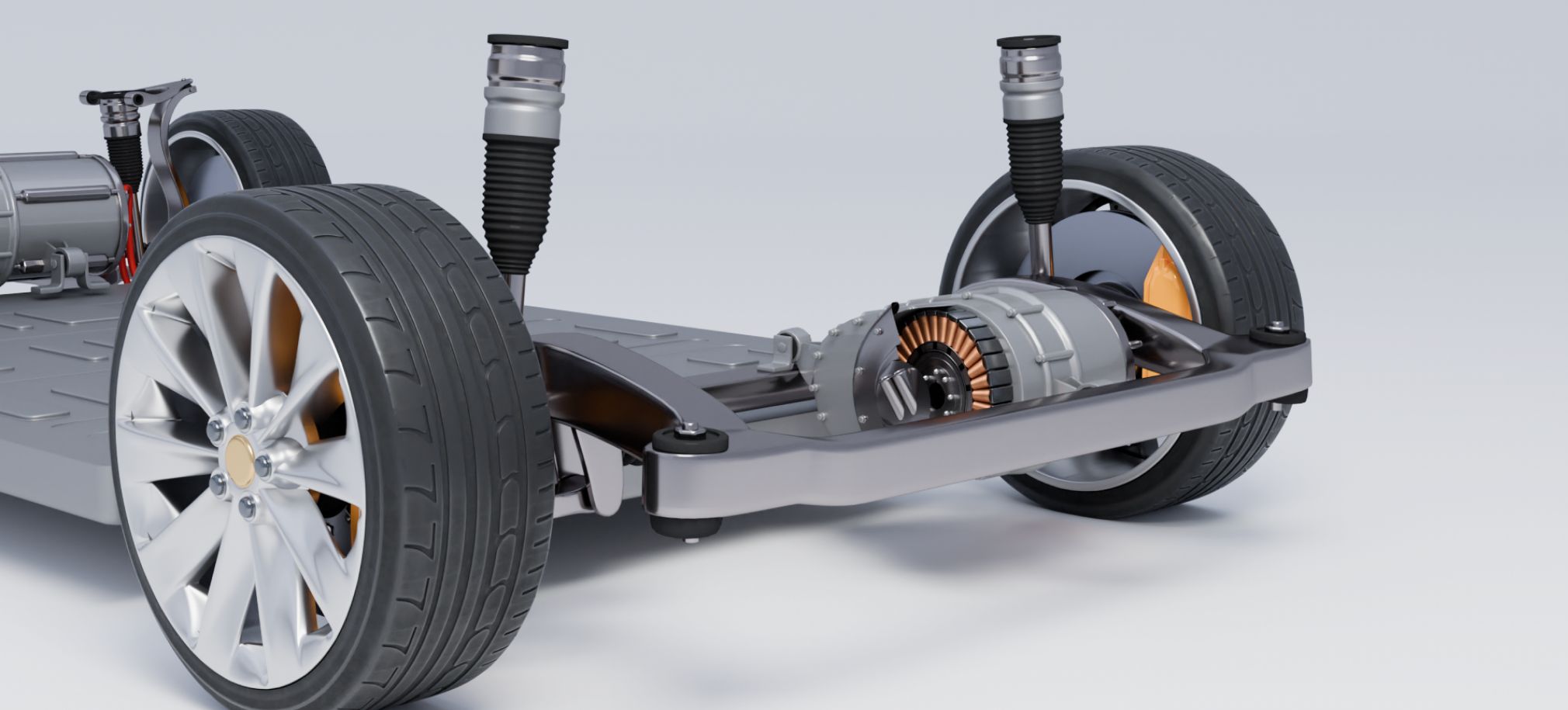
-
 Induction Motor
Induction Motor
-
 Automotive Electrical System Simulation
Automotive Electrical System Simulation
-
 DC/DC Bidirectional Converter
DC/DC Bidirectional Converter
-
 PWM Control for Brushless DC
PWM Control for Brushless DC
-
 BLDC Motor Control and Drive Simulation
BLDC Motor Control and Drive Simulation
-
 Electric Vehicle Fast Charger Simulation
Electric Vehicle Fast Charger Simulation
-
 DFIG Wind Turbine Simulation
DFIG Wind Turbine Simulation
-
 Dual Active Bridge
Dual Active Bridge
-
 EV Dynamometer Test Environment Simulation
EV Dynamometer Test Environment Simulation
-
 Electric Vehicle Simulation
Electric Vehicle Simulation
-
 Three-Phase Grid-Connected Inverter Using Direct-Q…
Three-Phase Grid-Connected Inverter Using Direct-Q…
-
 Three-Phase Grid-Connected Solar Photovoltaic
Three-Phase Grid-Connected Solar Photovoltaic
-
 Grid-Connected Rectifier
Grid-Connected Rectifier
-
 Grid-Tied Inverter System
Grid-Tied Inverter System
-
 Torque Control in a Hybrid Excitation Synchronous …
Torque Control in a Hybrid Excitation Synchronous …
-
 Wye-Delta Starting Circuit
Wye-Delta Starting Circuit
-
 IPMSM-Based Axle-Drive
IPMSM-Based Axle-Drive
-
 Simplified Parallel Hybrid Electric Vehicle
Simplified Parallel Hybrid Electric Vehicle
-
 Simplified Series Hybrid Electric Vehicle
Simplified Series Hybrid Electric Vehicle
-
 Series-Parallel Hybrid Electric Vehicle
Series-Parallel Hybrid Electric Vehicle
-
 Three-Phase Matrix Converter Simulation
Three-Phase Matrix Converter Simulation
-
 Venturini Modulation for Three-Phase Matrix Conver…
Venturini Modulation for Three-Phase Matrix Conver…
-
 Microgrid Frequency Regulation Using Vehicle-to-Gr…
Microgrid Frequency Regulation Using Vehicle-to-Gr…
-
 Three-Phase Modular Multilevel Converter
Three-Phase Modular Multilevel Converter
-
 Field-Oriented Control
Field-Oriented Control
-
 Interior Permanent Magnet Synchronous Generator
Interior Permanent Magnet Synchronous Generator
-
 Permanent Magnet Synchronous Machine
Permanent Magnet Synchronous Machine
-
 PMSM Rotor Angular Velocity
PMSM Rotor Angular Velocity
-
 PMSM-Based Electrical Traction Drive
PMSM-Based Electrical Traction Drive
-
 Maximum Power Point Tracking
Maximum Power Point Tracking
-
 Six-Phase Permanent Magnet Synchronous Machine
Six-Phase Permanent Magnet Synchronous Machine
-
 Synchronous Machine-Based Electrical Drive Simulat…
Synchronous Machine-Based Electrical Drive Simulat…
-
 Single-Stage Solar Inverter
Single-Stage Solar Inverter
-
 Three-Phase Cycloconverter Simulation
Three-Phase Cycloconverter Simulation
-
 Totem-Pole PFC Simulation
Totem-Pole PFC Simulation
-
 Twelve-Pulse Thyristor Rectifier
Twelve-Pulse Thyristor Rectifier
-
 Two-Wheeler On-Board Charger
Two-Wheeler On-Board Charger
-
 Vienna Rectifier Simulation
Vienna Rectifier Simulation
-
 High-Voltage Direct Current
High-Voltage Direct Current
-
 Wireless Power Transfer
Wireless Power Transfer

Comprehensive Documentation for Synchronous Machine-Based Electrical Drive Simulation
Table of Contents
- 1 Comprehensive Documentation for Synchronous Machine-Based Electrical Drive Simulation
- 1.1 Introduction
- 1.2 System Overview
- 1.2.1 What is a Synchronous Machine-Based Electrical Drive?
- 1.2.2 Purpose of the Simulation
- 1.3 Key Features
- 1.3.1 High-Efficiency Operation
- 1.3.2 Advanced Speed and Torque Control
- 1.3.3 Regenerative Braking and Bidirectional Power Flow
- 1.4 Simulation Objectives
- 1.5 Technical Description
- 1.5.1 System Configuration
- 1.5.2 Control Methodology
- 1.6 Advantages of Synchronous Machine-Based Drives
- 1.7 Applications
- 1.8 Simulation Benefits
- 1.9 Summary
- 1.10 Future Enhancements
- 1.11
- 1.11.1 Induction Motor
- 1.11.2 Automotive Electrical System Simulation
- 1.11.3 DC/DC Bidirectional Converter
- 1.11.4 PWM Control for Brushless DC
Introduction
The Synchronous Machine-Based Electrical Drive Simulation is a detailed model designed to analyze the performance, control strategies, and operational behavior of synchronous machine drives in industrial and transportation applications. These drives offer high efficiency, precise speed control, and robust performance, making them ideal for high-power applications such as electric propulsion, renewable energy systems, and industrial automation. This simulation provides valuable insights into machine dynamics, control algorithms, and power conversion processes.
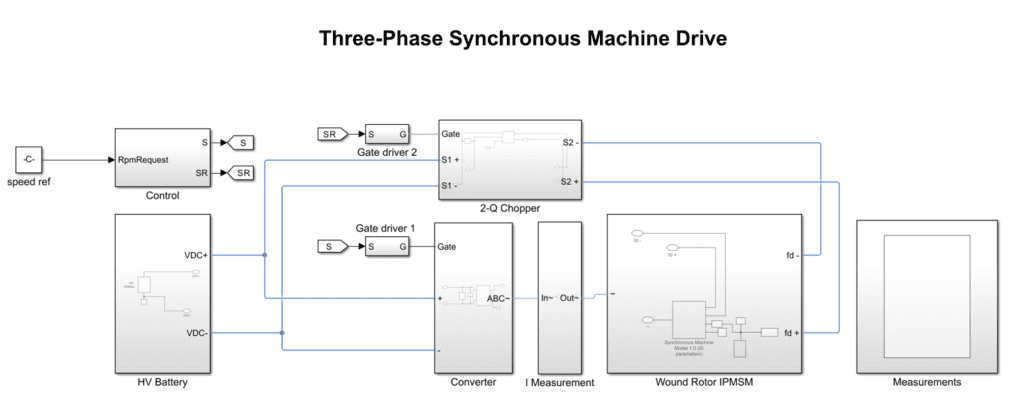
System Overview
What is a Synchronous Machine-Based Electrical Drive?
A synchronous machine drive consists of a synchronous motor or generator coupled with a power electronic converter and a control system. It operates with a constant synchronous speed determined by the grid frequency or control inputs and provides high-performance torque and speed regulation.
Purpose of the Simulation
The simulation aims to:
- Demonstrate dynamic behavior of synchronous machine drives.
- Validate vector control, field-oriented control (FOC), and direct torque control (DTC) strategies.
- Analyze power efficiency, torque ripple, and transient response.
Key Features
High-Efficiency Operation
Synchronous drives achieve superior efficiency by minimizing losses and precisely controlling magnetic flux. ➡️ HIL/PHIL Benefit: Real-time emulation ensures efficiency optimization under different operating conditions.
Advanced Speed and Torque Control
Vector control and DTC strategies enable precise torque and speed regulation for high-performance applications. ➡️ HIL/PHIL Benefit: Dynamic testing ensures smooth transitions between operating modes and load variations.
Regenerative Braking and Bidirectional Power Flow
The drive supports energy recovery by feeding power back into the grid or battery storage system. ➡️ HIL/PHIL Benefit: Impedyme platforms enable real-time evaluation of bidirectional power transfer and regenerative braking performance.
Grid Support: Synchronous machines provide inertia and reactive power support, enhancing grid stability.
Simulation Objectives
This simulation helps evaluate:
- Speed and torque control accuracy under various load conditions.
- Power factor correction and efficiency improvements.
- Dynamic response to sudden changes in load and input voltage. ➡️ HIL/PHIL Benefit: These evaluations allow real-time control validation and performance benchmarking before hardware implementation.
Technical Description
System Configuration
- Input: Three-phase AC power supply or DC source (for inverter-fed drives).
- Machine: Synchronous motor or generator with excitation system.
- Power Converter: Inverter-based or rectifier-fed drive system.
- Control System: Vector control, DTC, or other advanced control techniques.
Control Methodology
- Vector Control (FOC): Independent control of flux and torque components.
- Direct Torque Control (DTC): Fast response with minimal torque ripple.
- Field Weakening: Extending speed range beyond base speed. ➡️ HIL/PHIL Benefit: Control algorithms can be tested in real-time before field deployment.
Advantages of Synchronous Machine-Based Drives
- High Efficiency and Power Density: Optimized for energy savings and compact design.
- Precise Control: Suitable for applications requiring fine speed and torque adjustments.
- Regenerative Capabilities: Enables energy recovery for improved sustainability. ➡️ HIL/PHIL Benefit: Each feature can be validated across the full development cycle (RCP → HIL → PHIL) using Impedyme’s platforms.
Applications
- Industrial Motor Drives: High-Precision Manufacturing: Synchronous motors are used in industries requiring precise speed and position control, such as CNC machines, robotics, and textile manufacturing.
Compressors and Pumps: Synchronous drives are employed in oil and gas, chemical, and water treatment industries to improve energy efficiency and process control.
Conveyor Systems: Synchronous motors provide consistent speed and torque, making them ideal for material handling systems in mining, automotive, and logistics industries.
- Electric Propulsion: Used in trains, electric ships, and aerospace applications.
- Renewable Energy Systems: Wind Turbines: Synchronous generators are used in wind turbines to convert mechanical energy into electrical energy. Simulations help optimize performance under varying wind conditions.
Hydroelectric Power Plants: Synchronous machines are used in hydroelectric generators, and simulations ensure efficient power generation and grid synchronization.
- Power Generation and Grid Stability: Synchronous Generators: Used in thermal, nuclear, and hydroelectric power plants to generate electricity. Simulations help analyze grid synchronization, load sharing, and transient stability.
Grid Frequency Regulation: Synchronous machines provide inertia to the grid, helping maintain frequency stability. Simulations are used to study their role in grid stability under dynamic conditions.
- Industrial Automation: High-performance motion control for manufacturing processes. ➡️ HIL/PHIL Benefit: Real-time emulation accelerates development for industry-specific solutions.
Simulation Benefits
With this simulation, users can:
- Explore synchronous drive dynamics in detail.
- Test advanced control algorithms.
- Evaluate efficiency and power quality. ➡️ HIL/PHIL Benefit: Insights from simulations can be directly translated to real hardware validation.
Summary
The Synchronous Machine-Based Electrical Drive Simulation provides a powerful tool for understanding, optimizing, and validating advanced drive systems. By integrating Impedyme’s HIL and PHIL solutions, the development workflow is enhanced:
| Development Stage | Impedyme’s Contribution |
|---|---|
| Control Design | RCP using HIL for rapid algorithm validation |
| Control Hardware Testing | CIL with real-time machine models |
| Power Stage Verification | PHIL with real voltage and power interaction |
| Final Validation | Full-system PHIL under realistic grid and load conditions |
Future Enhancements
- Implementation of AI-based predictive control for efficiency improvement.
- Fault-tolerant control strategies for enhanced reliability.
- Real-time monitoring and adaptive control for grid-connected applications.
- Integration with smart grids and energy storage systems.
The Synchronous Machine-Based Electrical Drive Simulation, combined with Impedyme’s HIL/PHIL platforms, delivers a seamless development workflow from control validation to power-level testing. This comprehensive approach ensures faster deployment, reduced design risks, and improved efficiency for next-generation electrical drive systems.
